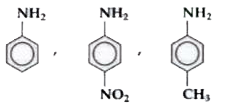The decreasing order of basic strength in
To determine the decreasing order of basic strength among the compounds given, we need to analyze the structure and effects of substituents on the nitrogen atom in each compound. The compounds in question are:
1. Aniline (C6H5NH2) - (I)
2. Diphenylamine ((C6H5)2NH) - (II)
3. Methylamine (CH3NH2) - (III)
4. Ammonia (NH3) - (IV)
Step 1: Analyze Methylamine (CH3NH2)
- Methylamine has a methyl group (CH3) attached to the nitrogen. The methyl group exhibits a +I (inductive) effect, which increases the electron density on the nitrogen atom. This makes the lone pair of electrons on nitrogen more available for protonation, thus increasing its basic strength.
- Conclusion: Methylamine is the most basic among the four compounds.
Step 2: Analyze Ammonia (NH3)
- Ammonia has no alkyl or aryl groups attached to it. The lone pair on nitrogen is available for protonation, but it does not have the additional electron-donating effects that methylamine has.
- Conclusion: Ammonia is less basic than methylamine but more basic than aniline and diphenylamine.
Step 3: Analyze Aniline (C6H5NH2)
- Aniline has a phenyl group (C6H5) attached to the nitrogen. The phenyl ring exerts a -I (inductive) effect, which pulls electron density away from the nitrogen. This makes the lone pair on nitrogen less available for protonation, thus decreasing its basic strength compared to ammonia and methylamine.
- Conclusion: Aniline is less basic than both ammonia and methylamine.
Step 4: Analyze Diphenylamine ((C6H5)2NH)
- Diphenylamine has two phenyl groups attached to the nitrogen. The presence of two -I effects from the two phenyl groups further decreases the basicity of the nitrogen. The lone pair on nitrogen is significantly less available for protonation due to the strong electron-withdrawing effects of both phenyl groups.
- Conclusion: Diphenylamine is the least basic among the four compounds.
Final Order of Basic Strength:
Based on the analysis above, the decreasing order of basic strength is:
1. Methylamine (CH3NH2) - (III)
2. Ammonia (NH3) - (IV)
3. Aniline (C6H5NH2) - (I)
4. Diphenylamine ((C6H5)2NH) - (II)
Thus, the final answer is:
(III) > (IV) > (I) > (II)
2. Diphenylamine ((C6H5)2NH) - (II)
3. Methylamine (CH3NH2) - (III)
4. Ammonia (NH3) - (IV)
- Methylamine has a methyl group (CH3) attached to the nitrogen. The methyl group exhibits a +I (inductive) effect, which increases the electron density on the nitrogen atom. This makes the lone pair of electrons on nitrogen more available for protonation, thus increasing its basic strength.
- Conclusion: Methylamine is the most basic among the four compounds.
- Ammonia has no alkyl or aryl groups attached to it. The lone pair on nitrogen is available for protonation, but it does not have the additional electron-donating effects that methylamine has.
- Conclusion: Ammonia is less basic than methylamine but more basic than aniline and diphenylamine.
- Aniline has a phenyl group (C6H5) attached to the nitrogen. The phenyl ring exerts a -I (inductive) effect, which pulls electron density away from the nitrogen. This makes the lone pair on nitrogen less available for protonation, thus decreasing its basic strength compared to ammonia and methylamine.
- Conclusion: Aniline is less basic than both ammonia and methylamine.
- Diphenylamine has two phenyl groups attached to the nitrogen. The presence of two -I effects from the two phenyl groups further decreases the basicity of the nitrogen. The lone pair on nitrogen is significantly less available for protonation due to the strong electron-withdrawing effects of both phenyl groups.
- Conclusion: Diphenylamine is the least basic among the four compounds.
Based on the analysis above, the decreasing order of basic strength is:
1. Methylamine (CH3NH2) - (III)
2. Ammonia (NH3) - (IV)
3. Aniline (C6H5NH2) - (I)
4. Diphenylamine ((C6H5)2NH) - (II)
(III) > (IV) > (I) > (II)
Topper's Solved these Questions
- BOOK - OP TANDONCHAPTER - BASIC PRINCIPLES OF ORGANIC COMPOUNDS (MECHANISM OF ORGANIC REACTIONS)EXERCISE - PROBLEMS FOR PRACTICE17videos
BASIC PRINCIPLES OF ORGANIC COMPOUNDS (MECHANISM OF ORGANIC REACTIONS)
- BOOK - OP TANDONCHAPTER - BASIC PRINCIPLES OF ORGANIC COMPOUNDS (MECHANISM OF ORGANIC REACTIONS)EXERCISE - BRAIN STORMING PROBLEMS14videos
BASIC PRINCIPLES OF ORGANIC COMPOUNDS (MECHANISM OF ORGANIC REACTIONS)
- BOOK - OP TANDONCHAPTER - BASIC PRINCIPLES OF ORGANIC COMPOUNDS (MECHANISM OF ORGANIC REACTIONS)EXERCISE - SINGLE INTEGER ANSWER TYPE QUESTIONS4videos
BASIC PRINCIPLES OF ORGANIC COMPOUNDS (MECHANISM OF ORGANIC REACTIONS)
- BOOK - OP TANDONCHAPTER - BASIC PRINCIPLESEXERCISE - SECTION V INTEGER ANSWER TYPE QUESTION3videos
BASIC PRINCIPLES
- BOOK - OP TANDONCHAPTER - CARBOXYLIC ACIDS AND THEIR DERIVATIVESEXERCISE - Integer4videos
CARBOXYLIC ACIDS AND THEIR DERIVATIVES
Similar Questions
Knowledge Check
- Question 1 - Select One
The decreasing order of the basic character of NH3,CH3NH2,C2H5NH2 and C6H5NH2 is
ANH3>CH3NH2>C2H5NH2>C6H5NH2BC2H5NH2>CH3NH2>NH3>C6H5NH2CC6H5NH2>C2H5NH2>CH3NH2>NH3DCH3NH2>C2H5NH2>C6H5NH2>NH3 - Question 2 - Select One
Increasing order of basic nature of
NH3(I),CH3NH2(II)andC6H5NH2(III) isAIII<I<IIBI<II<IIICIII<II<IDI<III<II
Arrange the following in incresing order of basic strength :
C6H5NH2,C2H5NHCH3,C6H5N(CH3)2.View SolutionArrange the following in increasing order basic strength :
(i) C6H5−NH2,C6H5CH2−NH2,C6H5NH−CH3
(ii) View Solution
View SolutionArrange the following :
In decreasing order of basic strength in gas phase :
C2H5NH2,(C2H5)2NH,(C2H5)3N and NH3.View SolutionArrange the following:
(i) In decreasing order of the pKb values:
C2H5NH2,C6H5NHCH3,(C2H5)2NHandC6H5NH2
(ii) In increasing order of basic strength:
C6H5NH2,C6H5N(CH3)2,(C2H5)2NHandCH3NH2
(iii) In increasing order of basic strength:
(a) Aniline, p-nitroaniline and p-toluidine
(b) C6H5NH2,C6H5NHCH3,C6H5CH2NH2
(iv) In decreasing order of basic strength in gas phase:
C2H5NH2,(C2H5)2NH,(C2H5)3NandNH3
(v) In increasing order of boiling point:
C2H5OH,(CH3)2NH,C2H5NH2
(vi) In increasing order of solubility in water:
C6H5NH2,(C2H5)2NH,C2H5NH2.View SolutionRearrange the following in an increasing order of their basic strengths :
C6H5NH2,C6H5N(CH3)2,(C6H5)2NH and CH3NH2View SolutionArrange the following in increasing order of their basic strength:
(i) C2H5NH2,C6H5NH2,NH3,C6H5CH2NH2and(C2H5)2NH
(ii) C2H5NH2,(C2H5)2NH,(C2H5)3N,C6H5NH2
(iii) CH3NH2,(CH3)2NH,(CH3)3N,C6H5CH2NH2.View Solution

